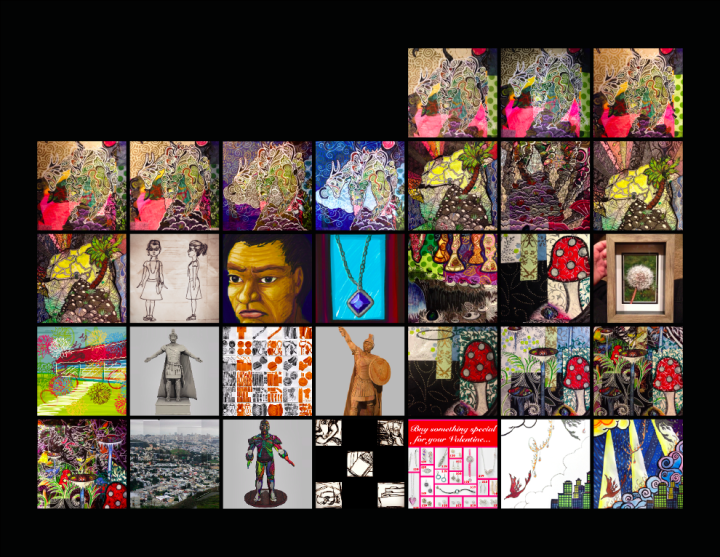
"Calendar" image of Daily Art created in January.
(Note: This image was actually created in February, but since I'm posting late I'm putting it here at the end of the month where it should go anyway.)

"Calendar" image of Daily Art created in January.
(Note: This image was actually created in February, but since I'm posting late I'm putting it here at the end of the month where it should go anyway.)
January 27th:
I stood my addict up from his crouched position and rendered him to show off the hidden elements of his texturing.
I've been working on the most recent pages of my Cut-Up Sketchbook for the past few days while I've been out of town:
Day 98:

Day 97:

Day 96:

Day 95:
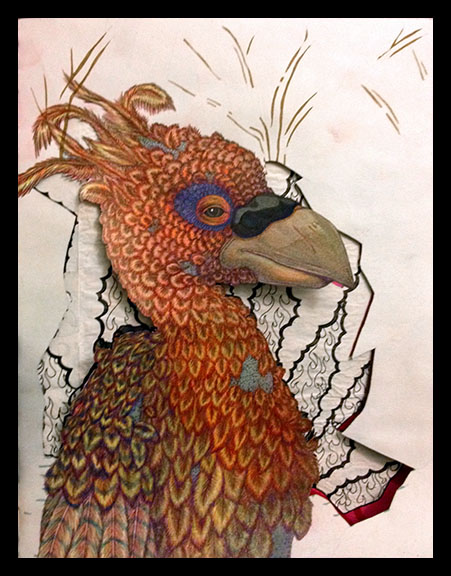
Then I spent this past weekend with my niece and nephew helping my sister prepare for my niece's birthday party, so the art on those days is all party and kid-related:
Day 94:
On Sunday I acted as the unofficial photographer of the birthday party. I won't post pictures of the kids online, but I will show a snippet of an action shot of the piñata smash:
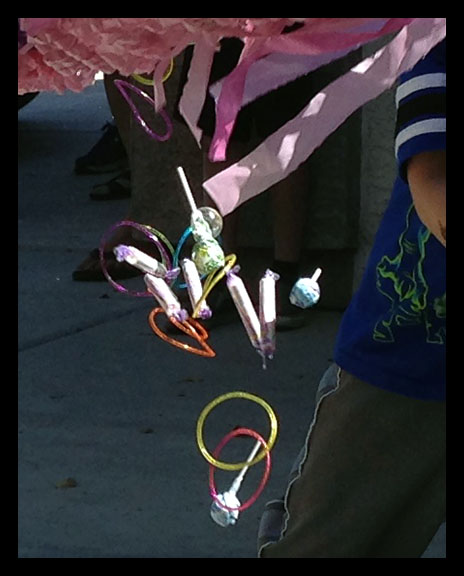
Day 93:
Saturday was cupcake decorating day:

The crab was following a design that my sister found (on Pinterest, I'm sure...)
Day 92:
On Friday I drew some pictures of "Frozen" characters for my niece and nephew that they chose to fold into fans. My nephew wanted Olaf and Sven, which he then colored before adding drawings of his own of Anna and Cristophe:

And my niece wanted Elsa, which I colored for her:

Day 91:
And before that was more Cut-Up Sketchbook:

Day 90:
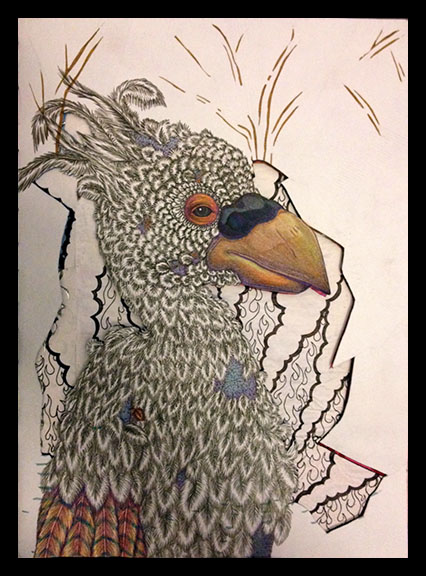
Day 89:
On day 89 I spent the better part of my work time taking screen shots, editing, and compositing progress photos for this blog. I think this qualifies as Daily Art considering the amount of time that I spent working in Photoshop, but it does not yield its own images. You'll just have to look at days 76-88 to see the results of day 89's work...
Day 88:
A tree:

In the form of a photo collage.
Day 87:
I made a list of all of the remaining tasks to complete in the revision of my Juggler's textures this day.


And then I decorated it:

Day 86:
The 86th day of Daily Art was a Saturday on which I spent 5 hours face painting. Here's a sample of my work:
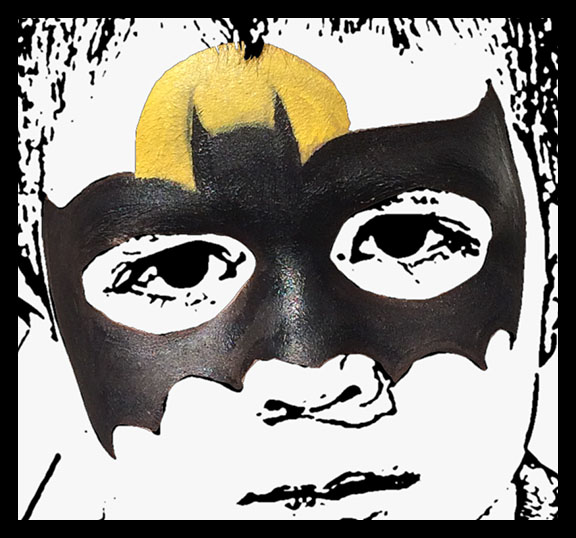
Day 85:
I also face painted on Friday:

And made a quick sign advertising the face painting:

Day 84:
On this Thursday and the two days before I spent time creating a 10 second long demo reel for my former school's Spring Show. As a student who was enrolled in the fall I still qualify for entrance into this year's show despite the fact that I've already graduated. This is the reel that I submitted:
Day 83:
I submitted that reel because I realized that the submission guidelines prohibited having any contact information anywhere other than the first frame of the 10 second time span (I edited out that frame for posting on the internet). This is the reel that I created the first time around (and the way that I would have left it had I had free reign).
Day 82:
This was the day that I began the reel-editing process.
And the day that I discovered that the resolution requirements were full 1920 x 1080 HD and that I had to re-render a couple of my turntables.
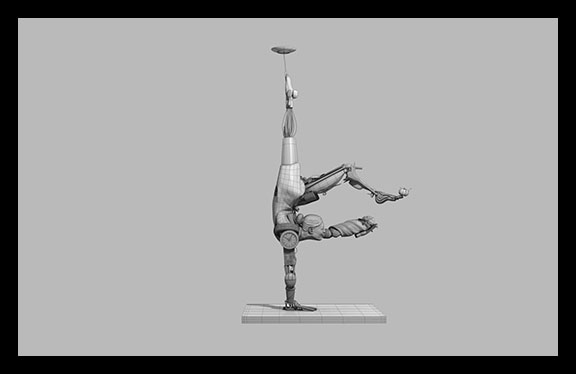
(such as the Juggler wireframe turntable that includes the image above.)
Day 81:
I spent this day trying to turn detail that I'd previously achieved through a normal map into detail achieved through a displacement map.
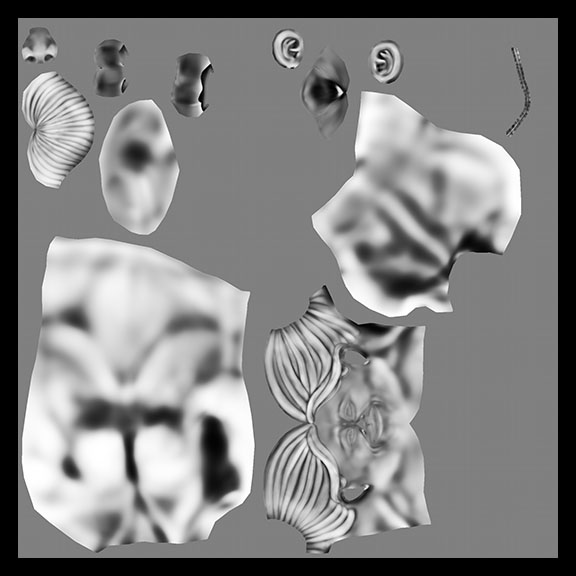
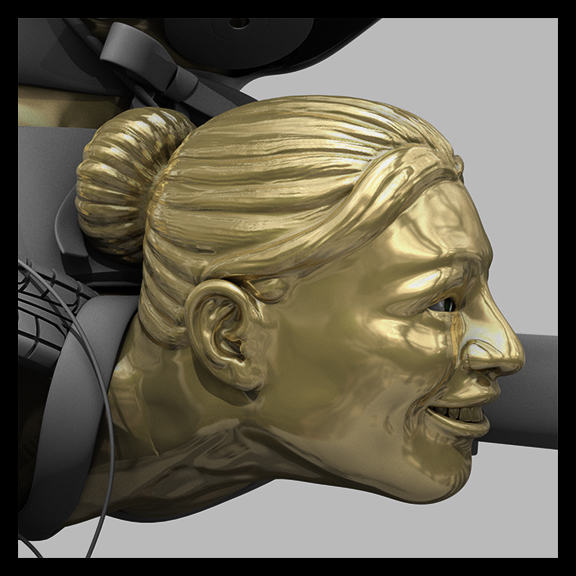
It worked in general, but lacked much of the sharp definition provided by the normal maps...
Day 80:
Daily Art day #80 was filled with technical behind-the-scenes stuff that provides no great imagery, like transferring sculpting from one object to another to utilize the UVs of the new item rather than the original one...
Day 79:
On this day I concocted some designs for face painting:
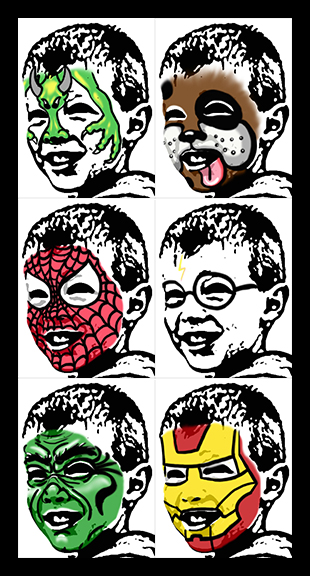
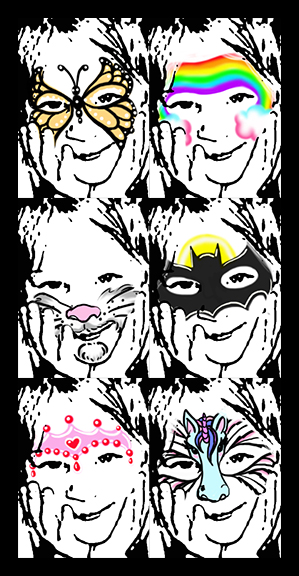
Day 78:
I reorganized my Juggler's UVs this day so that each individual piece of her won't require its own unique map when I texture paint her. I probably ended up averaging 3 - 5 items per map instead:
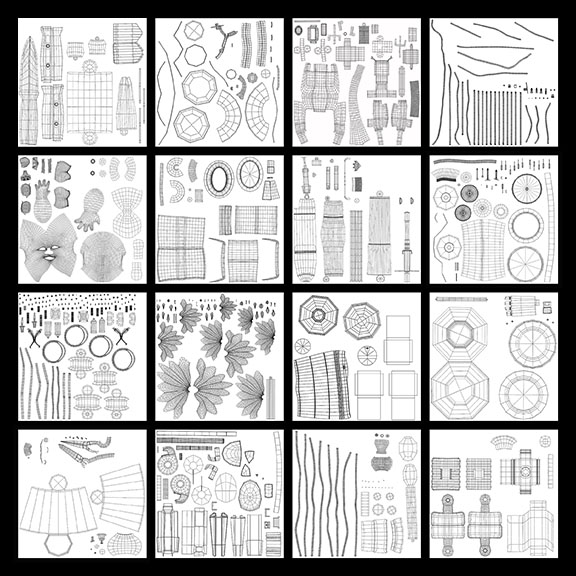
Day 77:
On this day I finished UVing every single piece on my Juggler so that I could really texture paint her rather than relying on procedurals as I did previously:
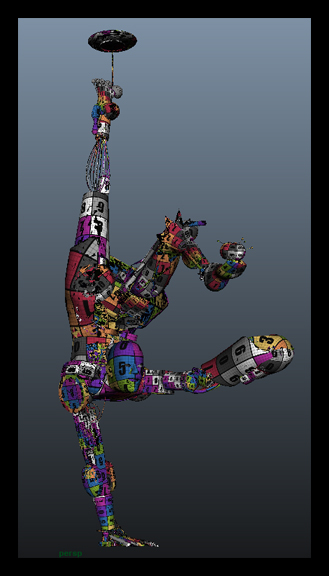
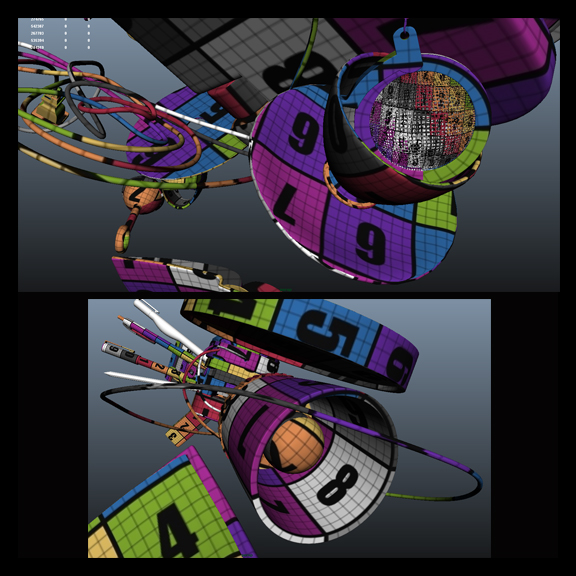
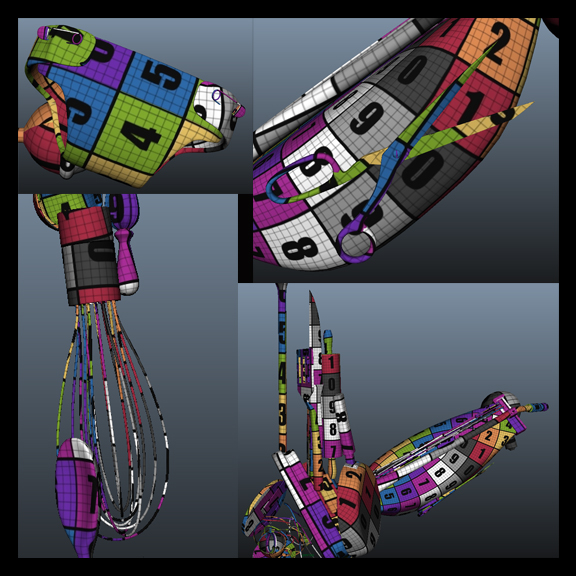
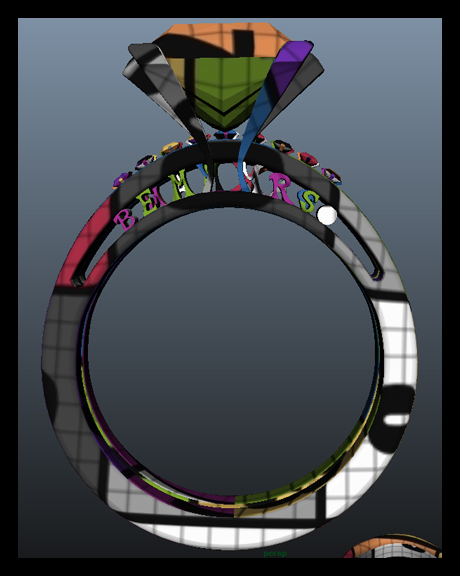

And, before that, I built a new mesh for the tire in my Juggler's shoulder:
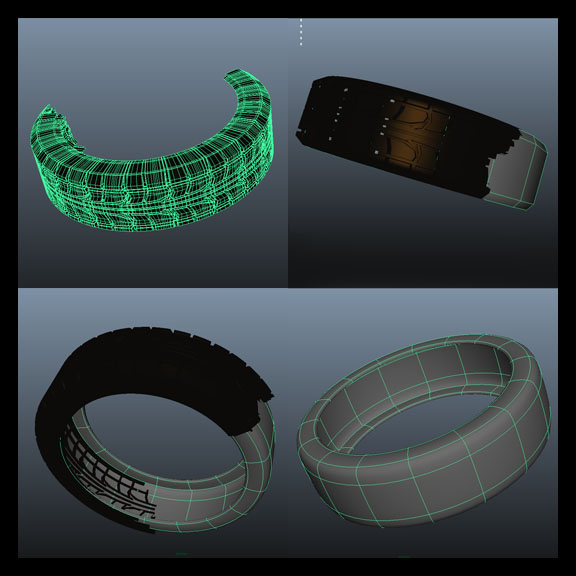
It has far fewer polygons than the tire with the modeled tread, but I think that I should be able to create the same look of a tread by creating a displacement map with the tread pattern in it.
Day 76:
And, finally, on the first/last day (depending on how you look at it) of Daily Art for this entry, I created a new, solid mesh to replace the very high-poly wire mesh in my Juggler's tea ball.
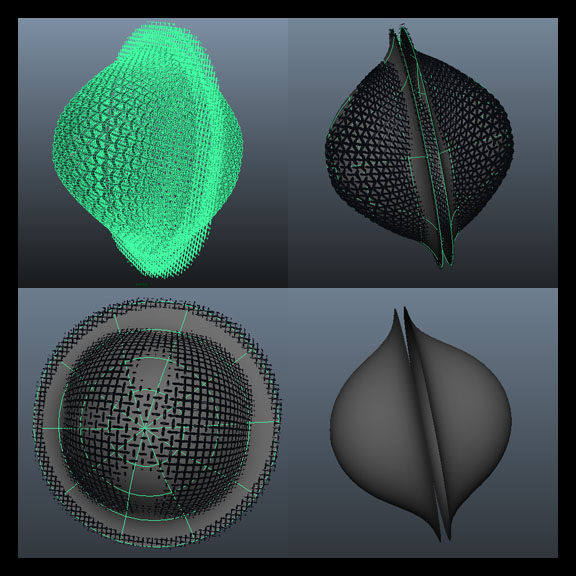
Then I created and tested displacement and transparency maps to use on the new mesh to make it look like it's built from the same wires as the original mesh:
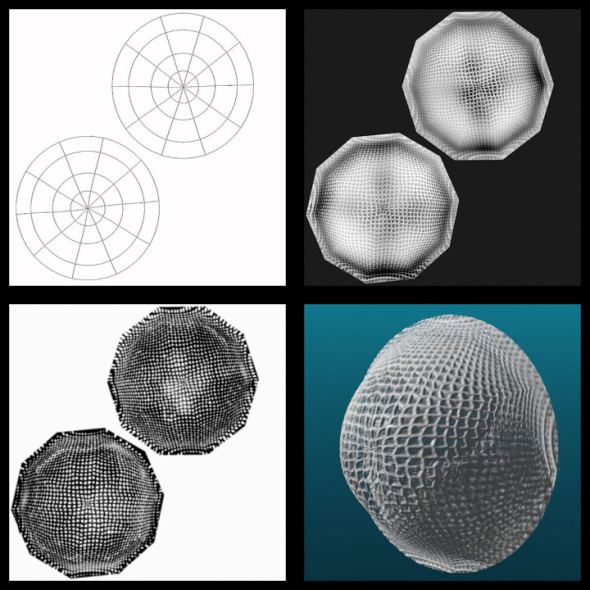
That's all folks!
It's been a busy week and a half since I last posted. I let a bit too much time get away from me between posts again, but it was for a very good reason: I put in an application to a Talent Development program at a major animation studio this week. Fingers crossed that something amazing comes of it! Now, back to daily art practices:
Day 75:
I revamped my demo reel a few times this week. Today I completed the most recent version; I fixed a couple of errors in the revamp that I completed earlier in the week. In the earlier version both my Gecko and my Juggler models disappeared shortly before the screen faded to black. One minute they were there, then suddenly they weren't, then the frame faded to black before progressing on to the next set of turntables. They both did this in slightly different ways for slightly different reasons, but I was able to identify both problems and adjust the file accordingly. I don't know how I missed it before I uploaded the version that I completed earlier this week to the internet...
Day 73 & 74:
I worked on the same thing two days in a row and never paused to take in-progress screen shots of it. So here is the finished image covering both days' worth of work.
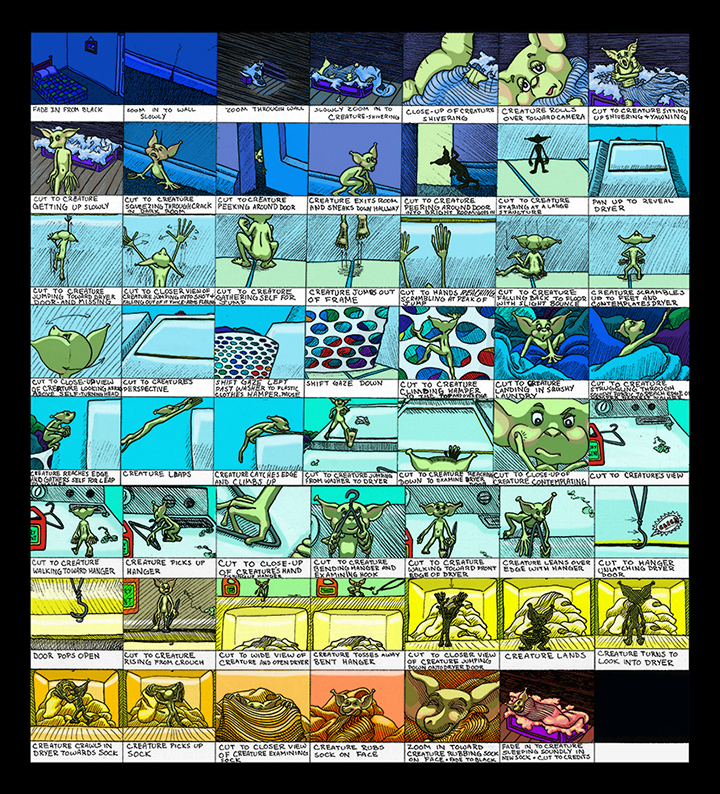
I didn't complete this entire storyboard in the two days that I worked on it. I actually began the thing a few years back, then lost interest in it in favor of other projects. It's been nestled in the back of my mind on my to-do list, however, and for some reason I really felt that it would be a valuable example to add to my Talent Development program application portfolio. Most of the work that I completed over the two day span was coloring the panels. All of the initial drawing and layout was already completed, and I had blocks of color multiplied over each panel depicting the dominant shade that I wanted each frame to be. The work that I did over the weekend was pretty akin to coloring in a digital coloring book of my own creation.
Day 72:
Saturday's work was just a quick sketch of a lion head. I found myself studying the contours of the face of a leopard whose photograph appears occasionally as my computer's desktop wallpaper and wanted to draw a new version of it. Changing the proportions of the face turned it distinctly lion-like, but, as I wasn't really aiming for any type of cat in particular, I was pleased with it. I'd like to turn this sketch into vector artwork in Illustrator someday.
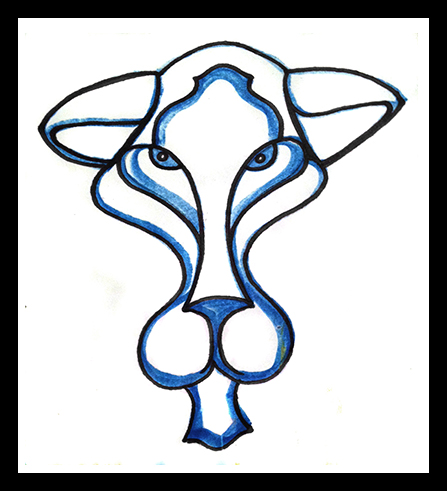
Day 71:
Friday I spent a short amount of time UVing the clock on my Juggler:
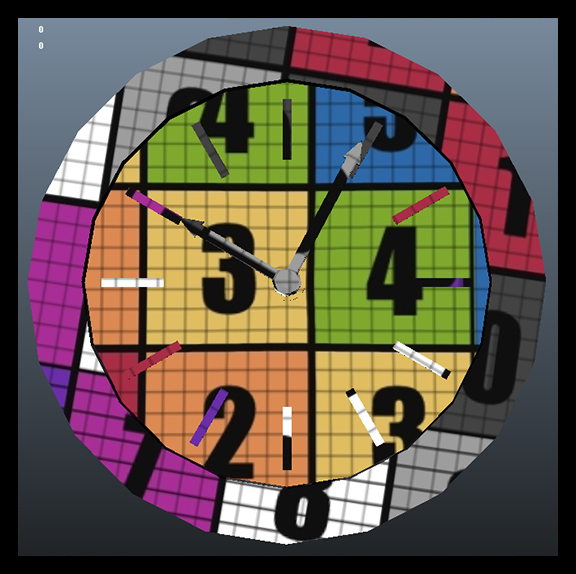

I've been UVing all of the Juggler's pieces separately because I started working on the character this way, but I know now that that was a mistake. Having a separate UV map for each piece of the character wastes space and makes the character far too data-heavy to function efficiently. I can't do much to fix all of the UVs on the objects that I've already added normal and texture maps to without re-doing an awful lot of work, but I can, and will, combine the UV maps of some of objects that have no texture information to them yet before I go about adding such information. I'm planning to dispense with the procedural textures that I gave the Juggler for my thesis and texture paint her in Mudbox instead. She will be a wonderful piece to add to my texture portfolio, which is distinctly lacking at the moment.
Day 70:
My art on Thursday consisted solely of a quick little face-painted mask of-sorts. More practice for when I begin doing this at the farmer's market.
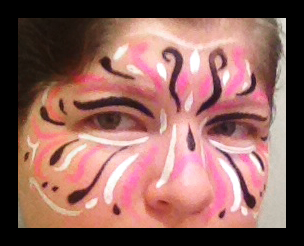
Day 69:
Wednesday was the day that I truly revamped my demo reel. I fixed the little issues that I missed later in the week, but this was the day that I truly put effort into working on it. It's fairly similar to the reel that I've been using (it features many of the same models with the same turntables), but the turntables are re-ordered to showcase my best models first. I know that this is how a demo reel should go: you show your best work first so that the recruiter who views 100 demo reels per day becomes interested immediately and doesn't just turn your reel off thinking that everything on it must be as mediocre as the first thing and move on to the next reel. I know that's how it works, and yet... I've been using my thesis reel because I know that it has my best models on it. The problem is: I designed my thesis reel to work up to my best work because I knew that the panel that it was intended for was going to watch the entire thing and then discuss it. I saved the best for last, which is exactly opposite of what you should do when you create a demo reel. And somehow, until quite recently, I missed the error. I never revamped my thesis reel to make it more appropriate as a demo reel in any way other than changing the slate information to be more suited to its purpose; until now.
The new reel puts my Addict first, followed by my newly-textured Gecko. Then comes the Juggler and the Warrior. Next is the Gallery environment. I nixed the still image of all of the models in the environment together because it no longer reflects the current state of the models now that the Gecko is textured; it also makes the addition of my Felix model tagged onto the end distinctly out-of place.
This version of the reel includes the 8-bit Dragon for "Amazing Adventure" at the very end after Felix, but I nixed that turntable later in the week when I fixed the errors in the reel because I'm just not happy with the quality of the turntable that I created for that model. It's not lit properly, the speed isn't constant, there's no wireframe view... It just looks unprofessional compared to the rest of the reel. Felix doesn't have a wireframe turn either, but the quality of the turn-around that he does have is so far above the one that I quickly set up and rendered of the dragon that I'm still satisfied having him at the end.
Day 68:
I spent the first three days of this round of daily art prepping my Szeth-Son-Son-Vallano model for 3D printing.

I'm not planning to sell him or anything of that nature, but, after the artist who designed the character said such nice things about the model, I figured that it would be nice to have a physical representation of him. I might even try to send one to the artist and the author who created the character if I'm successful; I know that the author, at least, really appreciates fan art.
Unfortunately, getting a model such as this ready for 3D printing is no easy feat. First off, The model has to be water-tight, which means one single, solid piece. When I built the model he consisted of exactly 15 different pieces. It also has to be under one million polygons, and the model that I built had something like 8 million quads if my memory serves me correctly. There is also a minimum thickness that any part of the model can be (how much that is depends on the material used to create the print), a minimum distance between two separate sections of the model (which means no intersecting or otherwise touching geometry), and a slew of other stipulations about the dimensions of the piece which will cause me less grief than the few that I have already mentioned. This means that I had to decimate the model to bring the poly-count down below one million while keeping all of my sculpted detail, and then connect all of the different pieces and any piece of geometry currently touching any other (this includes connecting the fingers resting on the surface of the model's face to the face as well as attaching the wrists to the sleeves and the coat to the shirt and the pants to the belt and every other piece to all of the other pieces).
I originally thought that I could complete the task of connecting all of the different pieces of the model fairly easily by putting all of the subtools on one layer in ZBrush and Dynameshing the entire thing, but it didn't work as well as I'd hoped. The geometry that Dynamesh produced needed so much clean up that it just wasn't worth it - at least by pixel-pushing and merging vertices in Maya I have more control and can keep track of what's going on with the shape of the model. I couldn't even make sense of all of the intersecting geometry that Dynamesh created...
So, after trying and failing attempted shortcuts in ZBrush a few times I brought the decimated model into Maya and have been merging vertices "by hand" ever since. The model will still require a lot more work before it's done, as well as some additional ZBrush sculpting to clean up the flow of the seams once the model is all one piece, but it's coming along:

The above image illustrates where I've deleted geometry from both the shirt and the belt in the areas that it overlaps. Next I will connect the vertices to make it water-tight.

This image clearly illustrates why the model will require extra sculpting in ZBrush to clean up the newly-created seams between the previously separate items.
Day 67:
On this day I connected Szeth's calves to the inside of his trouser legs:

This image shows all of the successful connections that I have made thus far:

Day 66:
The first day that I worked on Szeth I began by connecting his shoes to his feet.
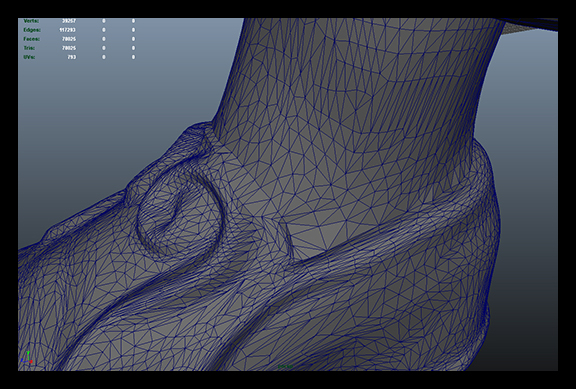
That's all that I did last week. The coming week should be very heavily Juggler-oriented, as I'm trying to create all-new textures for her in the hopes of submitting her for consideration in the Academy of Art's Spring Show. I think she'd be a fine fit for the Hard-Surface Model category.
Day 9:
Today's Daily Art was more technical than creative. I simply changed the information on my thesis demo reel slate to be more relevant to potential employers.
My final thesis video presented at my final review on Nov. 27, 2013.
Well, I'm posting my thesis progress from week 12 a bit late, and week 13 a bit early, but this is as good as it gets right now. I'm currently on vacation visiting my family for Thanksgiving, so I don't have much time to write an extensive blog post (or two). First, the news:
I passed my final review!!!
I presented my thesis to four reviewers and they all said that they were impressed, which was really nice to hear. They complimented me on designing a project that has a very good mix of hard surface and organic modeling elements and making it unique. I told them that I was planning to continue the project by texturing the untextured models for my demo reel and they agreed that that was a good idea. They said that the Addict was my best model and the Gecko second to it. They recommended that I go back and paint some more of the Juggler's textures by hand instead of using mainly procedurals, which I agree with emphatically. I've been wanting to do that, as well as adding some more bump and normal map graphics to some of the objects on her, but I knew once I got her to the point that she is at now that I had to stop working on her, call her "good enough" and move on if I was to have any hope of finishing the rest of the project to the standard that I desired. Their strongest criticism was that the Juggler still looks a bit too CG. They also recommended that I update my reel, because the models in what I dubbed "my reel" are all a bit dated, but, since I'm planning to basically use my thesis reel with a few minor tweaks as my demo reel, that's not something that I'm overly concerned about.
Finishing up the last minute changes to my reel and book, revising the book to turn it into a presentation format, and presenting my thesis was the bulk of the work that I completed in week 12. For week 13 I'm taking a break from my "Fearless" project and working on a model for a friend who will be presenting his animation thesis next semester. It's a pretty simple model (an 8-bit style princess), but it's taking a little while to build due to the fact that I'm working on my laptop rather than my PC, which is currently the more powerful of my two computers. My Mac doesn't have a whole lot of space left on it because it's an older computer, so my Maya is running quite a bit slower than I've become accustomed to. I've spent part of the day transferring unnecessary files to my portable hard drive, so I'm hoping that that will give my computer a little more power to speed things up, because it's tedious to select something and wait, and then move something and wait, and then select something else and wait again while trying to model. I'll post some progress pictures next week when I'm a bit closer to being done with her. Then, after she's done, I'll return to texturing my thesis models. I probably won't get very far into texturing before I take another break for the holidays, but I do expect to make at least a little progress since I'll need some kind of work to show for my last week of school.
This is my thesis demo reel. It won't be my final reel (I'm allowed to make changes to it up until Tuesday, the day before my review). It was going to be my final reel for a day or two, but both of my instructors had some concerns over the varying line widths in the wireframe gallery renders, and I recently discovered a new way to render wireframes in Modo, so I'm revising the wireframes in which the line widths currently vary. I will also be replacing the high-res Addict model with the low-res, displacement mapped one.
Here are my new wireframe gallery renders:
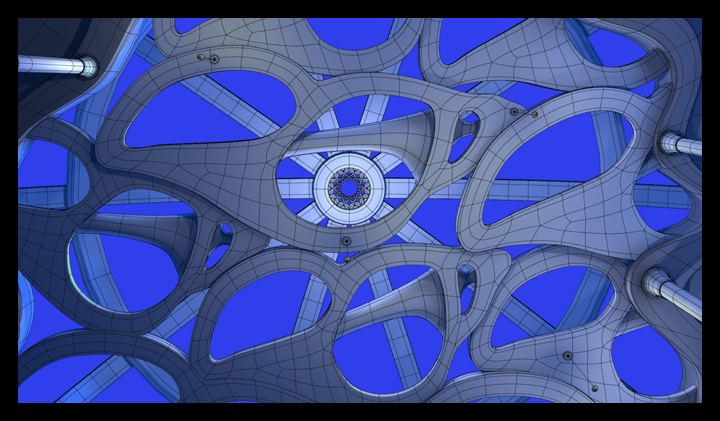
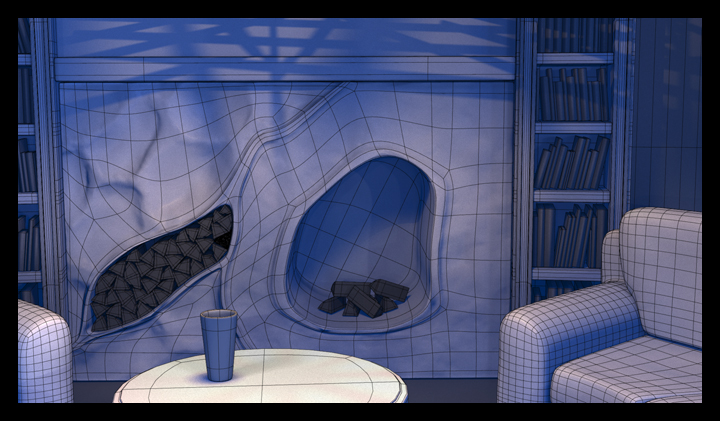
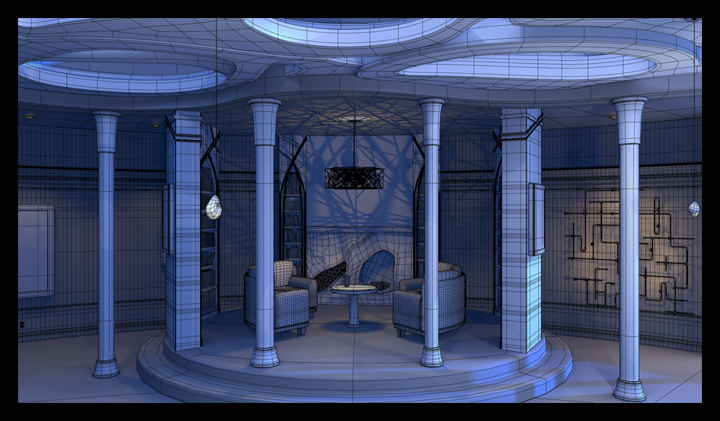
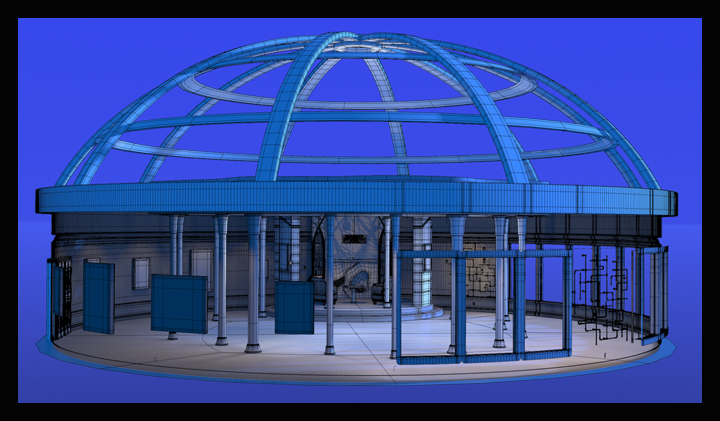
And here is my new Addict wireframe turn-around:

This model is just over 20,000 polygons rather than the 325,000 polygons that the higher-res mesh contained.
I am also working on an additional pose for my Addict to show off the texture work that I did in the areas where he has to pull himself apart to unfold:
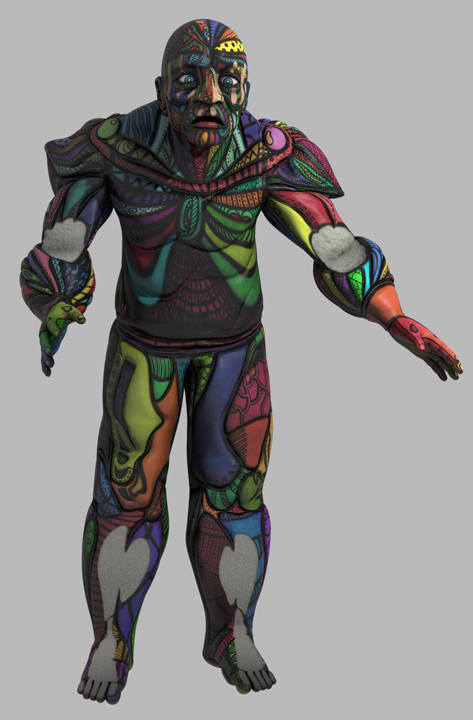
I'm not too happy with this image yet, but I'm having a hard time deciding how to fix it. His calves are much too wide, his head is too far forward still, and there are a few places where the geometry got tweaked in such a way during the posing that it's pulling on the texture. I can fix the first and last problems pretty easily: for the last problem I just need to make my final adjustments to the geometry with the texture applied, rather than blindly tweaking the low-res mesh alone, and to fix the first problem I just need to re-pose the head and the eyes. The width of the calves is the problem that I'm really wrestling with. They are currently as wide as they are because he was supposed to be built kneeling, which flattens out the calves quite a bit. Since he is supposed to be rigid, I feel like those calves should remain as wide as they are to keep the integrity of the character. However, it looks bad. It looks like I don't understand basic anatomy, and since this is a portfolio piece to show my skill, that's a problem. I think that I'm going to just end up fixing the shape of the calves until it looks better, but I still feel like I'm betraying my concept for the character by doing so...
Anyway, those are the changes that I expect to make to my presentation in the next couple of days. As far as the work that I did to submit my thesis, however, it all came together pretty easily. I made/modified After Effects compositions for each of my characters and my environment and perfected their individual video segments in their own space, then I put all of the compositions together into a larger composition in which I created the transitions between the turntables and added the concept art frames and informational slates. Then I worked on the book. Well, actually, it wasn't so much "one then the other". I had already started work on the book prior to this past week, but as far as the order in which I pulled all of the pieces together goes, it was the reel first, then the book. It took me until Monday or so to get all of the beauty shot renders done. Then I had to go through them and prepare them for the book by adjusting and merging the layers of render passes and cropping images when necessary. I finished the written portions during render time. Then I just put it all together into a book format as best as I could. Here are a few sample pages:
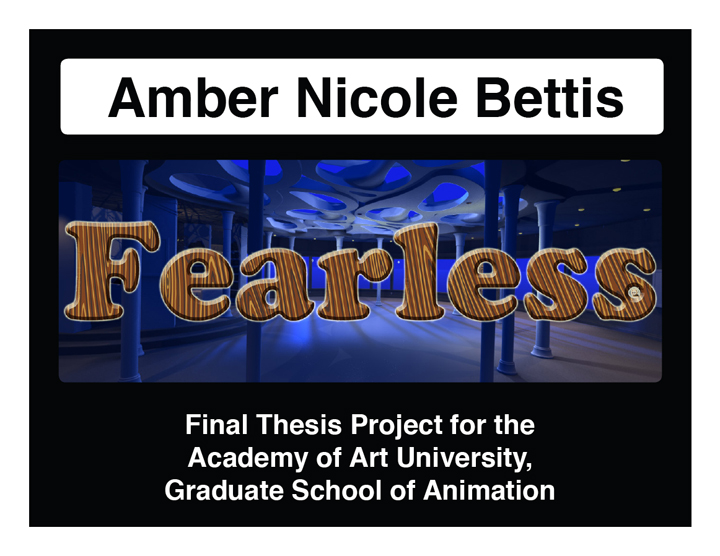















(I think that I forgot to mention that I re-rendered the inhabited gallery scene to produce the image in the page above. I moved the models around a bit, added some extra lights, and used a wider angle lens for the shot. At first, the shot had the same issue that I was having when rendering my Juggler: disappearing polygons and jagged-edged meshes. Then I finally stumbled upon a solution to the problem online: I had to increase the geometry cache size in the render settings. The time to render this frame dropped from over eight hours the last time around to only three hours with the geometry cache raised. Needless to say: I approved.)

The whole book is 83 pages currently, but will probably expand to 85 by the time I add the revisions.
This post is late because I spent last weekend and the early part of this week bringing all of the elements of my thesis together rather than blog-writing, but it's all done now: my thesis has officially been submitted!!!
I'll go into the details of how I finished it off when I post my week 11 journal entry this weekend, but, for now, here's what I did during week 10: I rendered. That's about it. I mean, I spent some time writing my thesis summary for my presentation book, but mostly I rendered. I rendered beauty shots of models whose turntables were completed, all of the extra frames for that gallery turn-around (which works like a dream now, by the way), and wireframe images for my gallery. Here are a few examples:


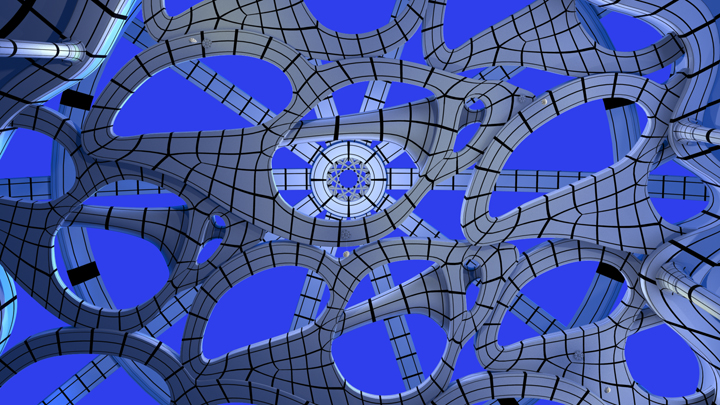
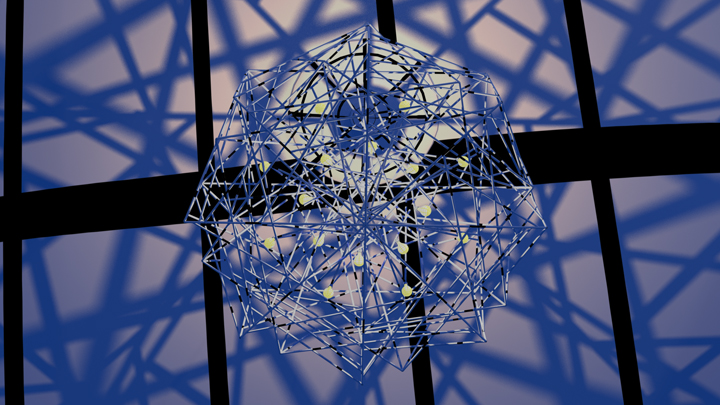
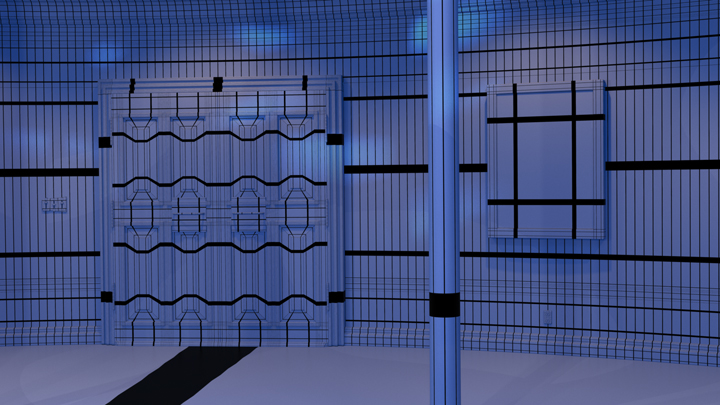

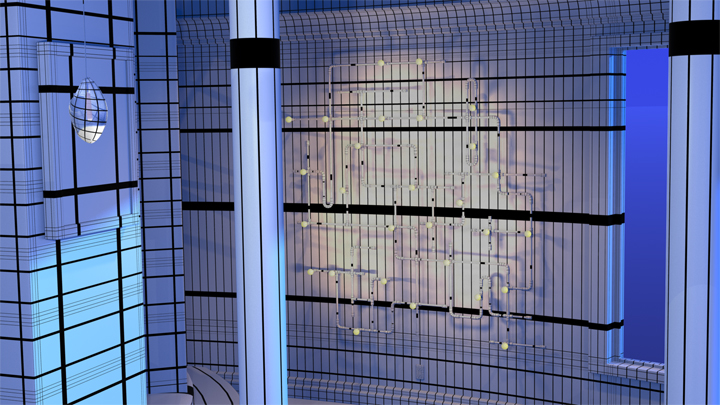
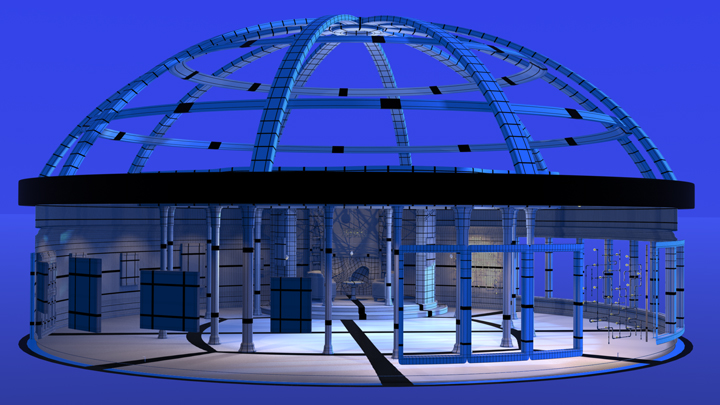
I was fairly pleased with these wireframe renders, but both of my instructors expressed concern over the varying line width. I'm currently working on finding a solution to this problem.
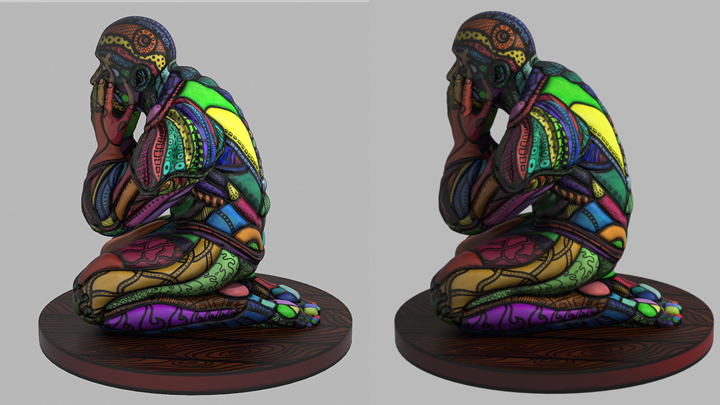
I also sought advice on my Addict model this week. I don't recall if I've mentioned this before, but after I made the displacement maps for my Warrior I decided to try generating displacement maps for my Addict so that I could bring down his poly-count. It worked fairly well. He looks good everywhere except for that ridge down his spine which has been problematic ever since I brought the model out of ZBrush. That ridge flattened out quite a bit again, but it doesn't look completely horrible. I couldn't decide whether I should re-render all of his turnarounds with the low-res mesh with displacement or just keep the turntables that I already had. One of my instructors told me to stick with the high-res model while the other told me that if I was really concerned about it I could always keep the high-res textured turnaround and just re-render the wireframe with the lower-poly model. I decided to do the new renders at least, but I haven't fully decided whether to actually make the switch in my project yet. (Even though I already turned in my project I can make revisions up until the day before my review.) I'm really happy about being done, so I'm tempted just to leave it as is for now and wait to make any further revisions until I start texturing the untextured models after I graduate, but I also want to ensure that I've put my best foot forward for my presentation, so we'll see...
It's official: I have a date for my final review: November 27th. The day before Thanksgiving. This means that I'm either going to have a spectacular or a really bad holiday (hopefully the former). This also means that I have until the 13th of November to finish my thesis and presentation. This isn't the greatest news since I discovered this week that my gallery takes 40-45 minutes per frame to render, but it's also fantastic news given that it provides me with the extra week that I knew I'd need past the earliest possible deadline that I could have had.
The first thing that I worked on this week was my gallery, and thank goodness for that! I started work on it first because I figured that I'd get it out of the way - get it off of my plate while I finished up my Warrior and started work on my presentation materials. Then I discovered how long it took to render a finished frame and I think that I died a little...
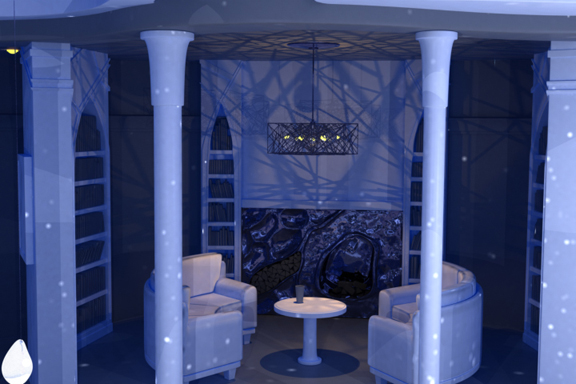
Ok, so that kind of statement may be a bit over-dramatic, but it feels right. I only got my date on Friday, so as far as I knew for most of the week I had the potential for having to turn my entire thesis and presentation in on Monday, November 4th (the day that I'm writing this, as it happens) and there was no way that I could finish everything by then with the renders taking that long. I did the math and discovered that I would need over four straight days and nights of rendering to finish just the essential frames that I needed for my thesis. And I still needed to finish sculpting, normal-mapping, and rendering my Warrior. Not to mention compositing my whole reel and finishing all of my presentation materials - which would require additional beauty shot renders. Thankfully, I have two computers that I can work on (which is how I'm currently rendering gallery frames while typing up this journal entry), but only one has enough RAM to render from Modo in a manageable time-frame (the 45 minute renders on my PC took over 3 hours each on my much older Mac laptop) or handle models with over 10 million polygons in ZBrush. I can work on my presentation materials and directed study journals on my laptop, but the most crucial and time-consuming elements of my thesis all require the same computer to function efficiently, and 4 straight days of rendering did not fit the schedule.
Thus, this past week was incredibly stressful as I waited to find out my date - all the while hoping against hope that I would get a presentation date at least a week later than the earliest one so that I could fit my newly-expanded gallery render time into the schedule. Any time that I haven't been working directly on my PC I've been rendering on it, and I got a pleasant surprise last night when I discovered that the second half of the gallery turntable frames have dropped in render time from 45 to 40 minutes per frame. (That extra 5 minutes makes quite the difference in the long run!)

The first thing that I did in my gallery was finish laying out those newly UVed logs that I mentioned in my last post, then I brought everything into Modo. It was there that I discovered that my couch normal maps looked terrible. I ended up using a slightly higher resolution version of the sculpted couches (one subdivision level up from the lowest level which is pictured in the image above) and re-baking the normal maps to get a much more pleasing result:
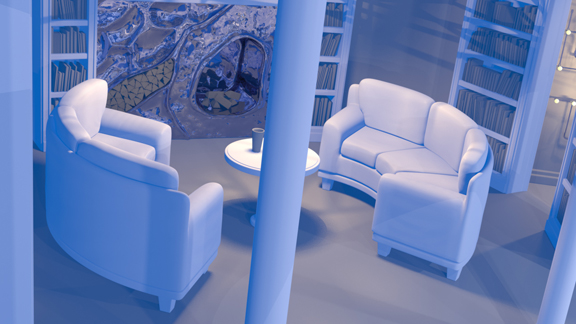
I spent a full day adjusting the render settings of the scene to account for odd graininess and scattered light beams and harsh-edged shadows and highlights in the initial images that I was rendering, and I'm pretty happy with where I ended up. The only trouble that I'm having now (aside from astronomical render times) is trying to decide which final color pass I want to use for my turntable:

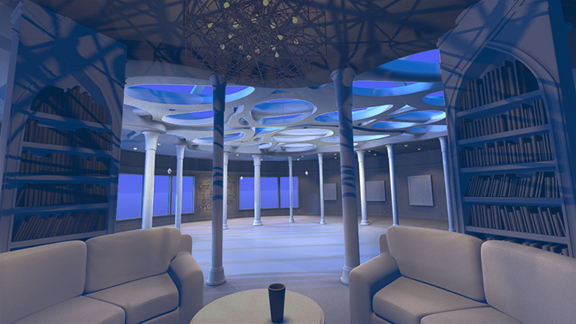
I really like the contrast of the darker view,

but I worry that the lighter frame might just show off the model better...
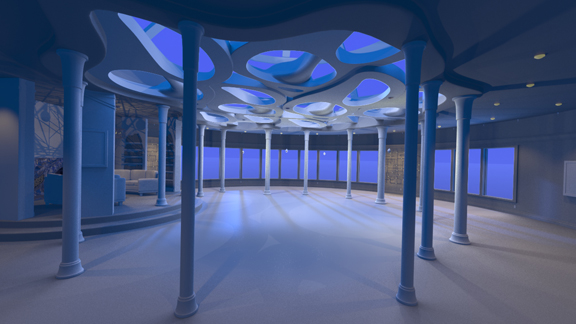
I'm waiting for opinions from this week's critique to make my decision fully. I'm rendering both passes with each frame (it doesn't seem to change the render time to have two passes instead of just one) so I have until I finish all of the renders and start compositing my fly-through to make my decision.
In addition to my gallery, I also finished posing and sculpting my Warrior character this week:
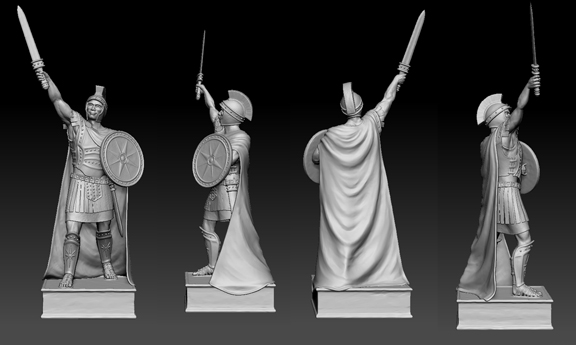
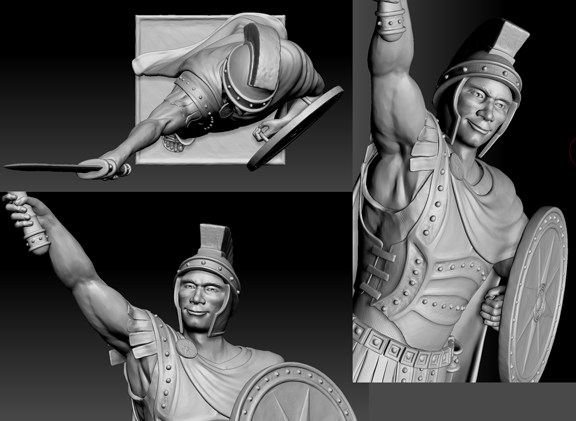
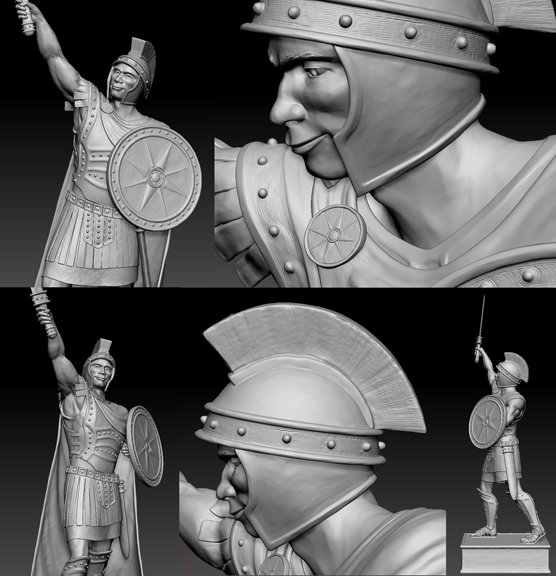
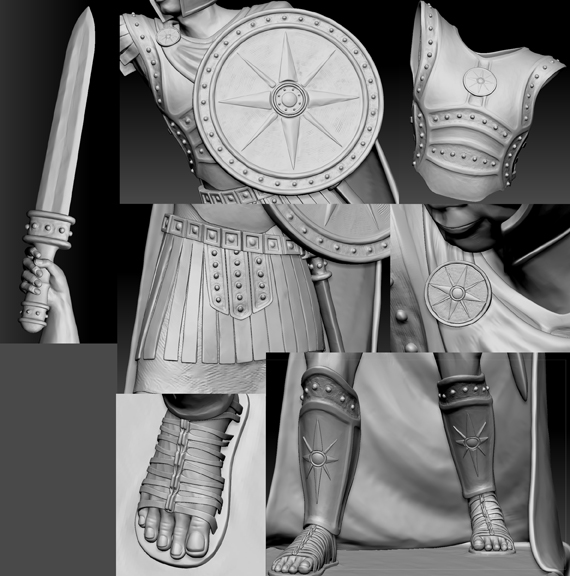
I'm quite happy with him. I think that the pose came out really well and I think that the surface texture really looks like it could be chiseled wood. I'm especially happy with the rake-tool details; they're the kind of marks that I noticed all over the real wood sculptures that I was using as reference. Now I'm just hoping that the normal maps that I need to bake in the next day or two capture the detail on him properly.
The last things that I worked on this week were compositing the completed turntable renders of my Juggler and Addict characters. I think that my Juggler still needs some work on the timing, but I'm pretty happy with where my Addict's at. I'll fix my Juggler's issues when I composite my whole thesis reel together this coming weekend, but, for now, enjoy:
At the start of my fourth week of directed study I was concerned that my character's body had lost much of the volume that I had sculpted into the high resolution mesh. I had particularly noticed it in the shapes going down the character's back: according to my character design, you're supposed to be able to see those shapes puff out from the back a bit, but the back was nearly a flat curve. I had checked to be sure that the second subdivision level mesh that I exported from ZBrush retained volume in the shoulder area and detail in the face and fingertips, but I hadn't ever had an issue with a character's back, so I didn't think to check it. It was, however, a problem that was bugging me greatly - and one that I couldn't figure out how to fix without having to bake out all new normal maps and re-do all of the texture painting I'd done.
The problem was: I had changed the Uvs after choosing the second subdivision level of the ZBrush model to export as my low-res mesh to apply the normal map (created from the high-res mesh) to; therefore, I couldn't just export a higher resolution model that would hold the sculpted volume better and apply the same texture maps that I had created to it because the UVs wouldn't match up.
Then I had an epiphany: I could project the high-res detail from the ZBrush sculpt onto a subdivided version of the current mesh that I was using that matched the texture maps. Then I would end up with a mesh that had all of the subdivision levels, detail, and volume of the ZBrush sculpt, but with the same UVs that I had been using to build my texture maps. I even discovered that my current normal map functioned just as well when applied to the higher-res mesh as it did whern applied to the low-res one; I didn't have to bake a new one!
Below is a comparison with some of the most visible differences between the lower-res mesh that I started out working with and the final mesh that I decided to use pointed out:
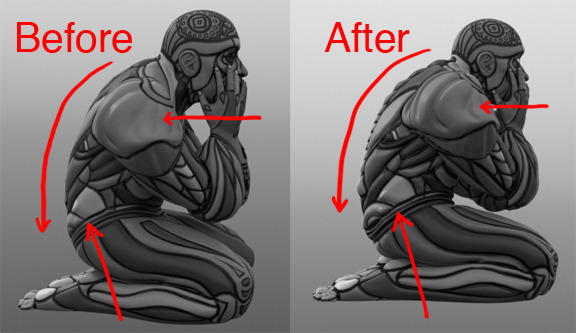
And the resultant character with the current texture maps that I had produced applied:
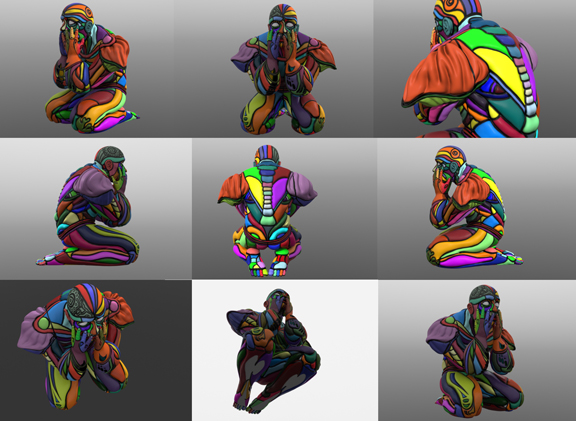
Then I really got down to texture painting, and found out that I had grossly underestimated how long it would take to doodle for this kind of work...

As I mentioned in my last post, I had spent a day painting the texture map that you see on the character above. I had nearly all of the precise linework done. I figured that would be the most time consuming part of the process. I know that one can spend a very long time doodling; I've spent hours filling up a single page with doodles in the past. Key word: "hours", not "days"... Turns out, days is what it takes to doodle textures on a character like this. In fact, it takes the better part of a week working straight through with breaks only for necessities like eating and sleeping. I was blown away. I know that I have a tendency of underestimating how long projects will take me, but this was ridiculous... I had reference. I knew that it took me a day for the precise stuff and that doodling isn't that precise and therefore should require less time. I knew how long I'd spent doodling on paper in the past... I didn't realize that doodling on the computer with my tablet would be as different as it was.
Anyway, here are the results of my week spent texture painting:
Addict Color Map:
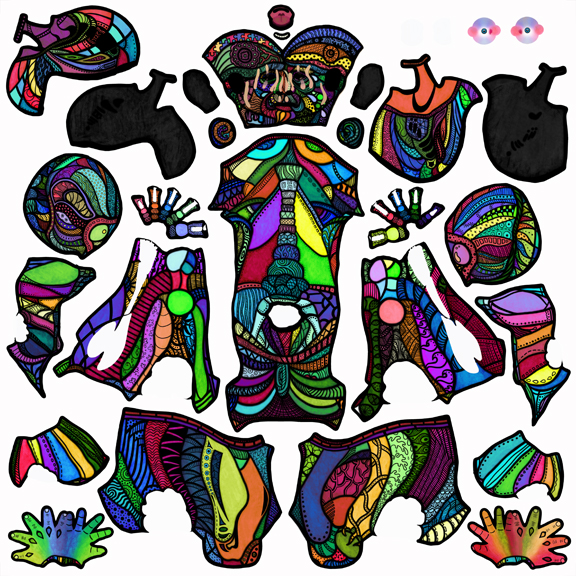
Addict Bump Map:

Addict Specular Map:

Addict Material Layer Mask:
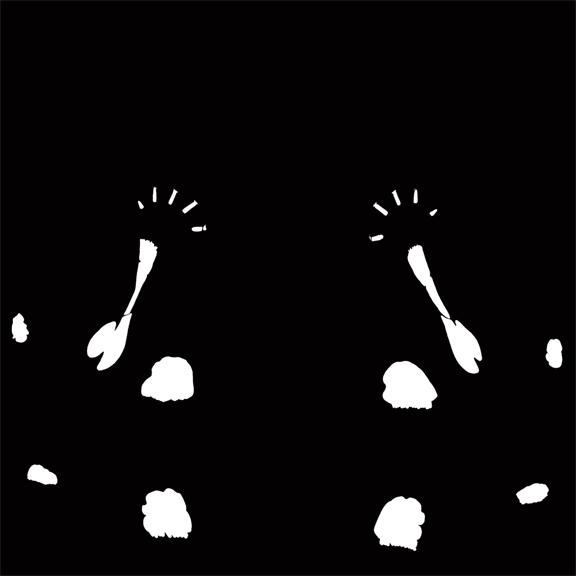
(The layer mask is to distiguish the portions of the model that have a raw plaster texture on them rather than a painted plaster surface, as the entire visible portion of the sculpture does.)
The Maps on the Model:
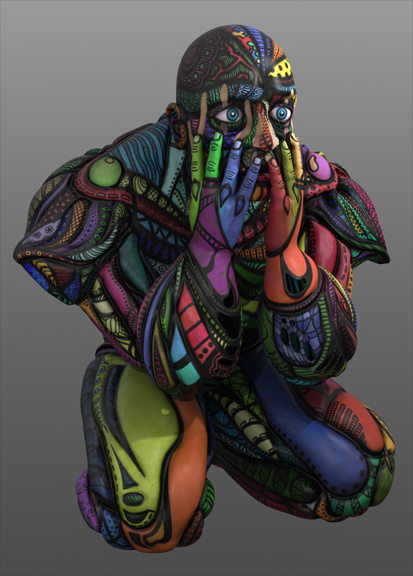
I'm very happy with the way he's turned out, but one of my favorite parts of him is one of the least visible:
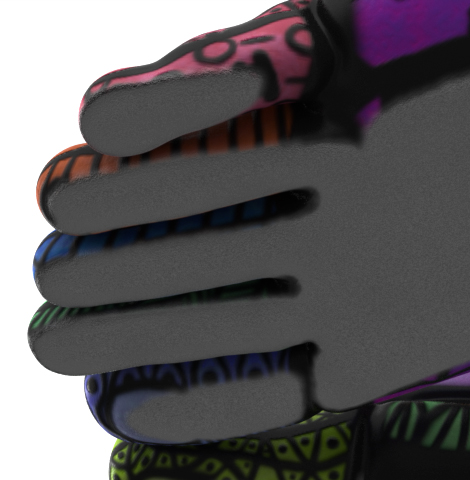
Now, you may be wondering why I'm so excited about the bottom of a foot (or, more accurately, since the character's on his knees, the top of a foot). What I'm most excited about, aside from the areas where the raw plaster sections transition into the painted portion of the model (which I think look very realistic, on the pink and orange toes especially), is that this is the first example of any work that I've done in Mudbox. That's right: I finally got around to trying it. I've been telling myself that I'll learn it eventually, whenever I finally work on a project that actually requires it, but I've produced surprisingly few textured models in my time at the Academy. I'm working on a "modeling" degree, not a "texturing" one, so I guess it makes a certain amount of sense, but, still, I'd have liked to have done more texturing in my time here. Anyway, back from my tangent: I had very visible UV seams showing up in this area where each toe meets the main body of the foot: the division line between the white plaster and black painted areas of each digit were uneven at those points. So, I took the model into Mudbox and painted out the seams. I'm very happy with the results. I know it's not an extravagant use of the program, but it's not bad for using a program for the first time with no training, if I do say so myself!
After I finished the texturing I set up turntable lighting, then decided that if he was going to be spinning he should have some kind of base to do it on, so I came up with this:
The Base:

Base Color Map:

Base Bump Map:

Base Specular Map:
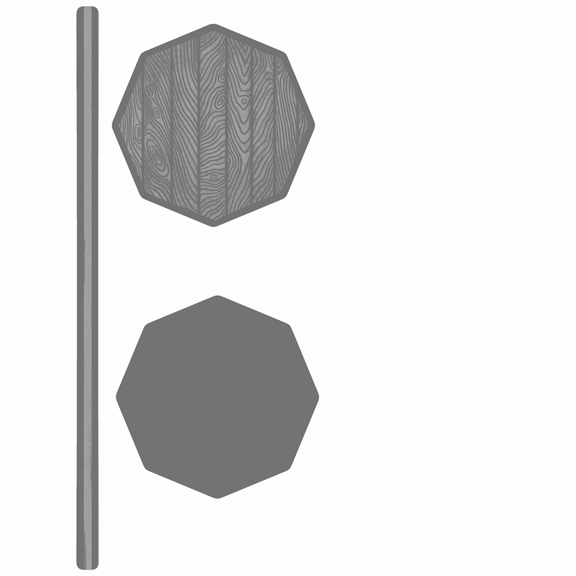
The base took a couple of extra hours to make and texture, but I think that it's worth it. It should give my character turntable just a little extra "oomph", as they say. I think that he looks better spinning on a base rather than floating in mid-air. I did one final test render before I began rendering the turntable a few days ago. (And, if you're wondering, yes, it's still rendering at the time that I'm posting this blog entry. I haven't had it rendering straight through, but, regardless, the amount of time that this turntable will have taken to render when it's done will be measured in days, not hours). This is the image that I got:
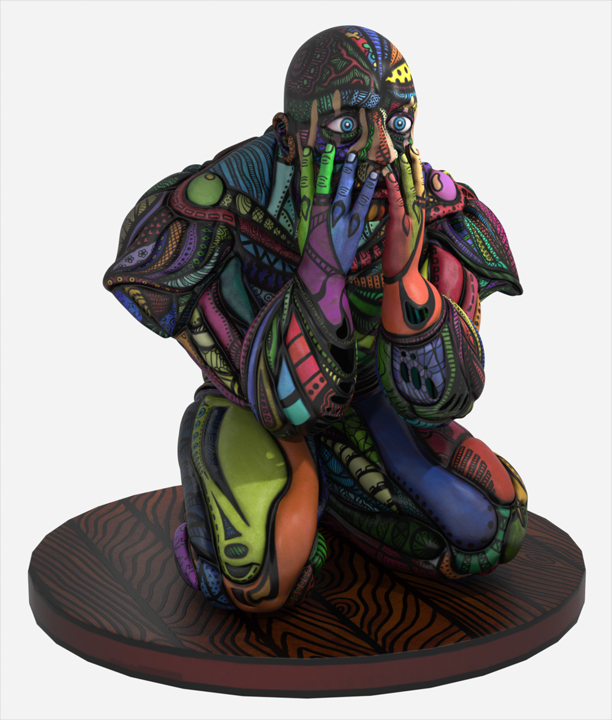
I have since fixed the faceting on the base by setting it to render at a higher subdivision level. In fact, the image of the base by itself above was my test of the higher subdivision render, and is what it will look like in the final turntable. Once that render finishes, I will move on to rendering the wirframe and flat-shaded versions of this model, then I'll start rendering my Juggler. In the meantime, I'm also going to work on my gallery models in the coming week; I'm really excited about building the fretwork ceiling and the crazy light fixtures. I'll be working during the day and rendering at night - here's hoping that after this month is over my computer and I will both get a break for a little while, because, until then, it's work, work, WORK!
At the beginning of my third week of directed study I took a day off from sculpting my Addict and worked on building my Gallery structure. I built the walls as panels that I could duplicate around the room, but I had a bit of an issue with the curvature of the round room.
If I built the walls at a low resolution as I originally planned, the shape of the room would still be perfectly round everywhere once I welded the panels together and smoothed them except at the windows, where I was forced to put in extra edge loops to fit the window frames into the panels. The portions of the wall with the windows would have lost their perfect roundness and instead become slightly faceted as the extra edge loops held the geometry in place rather than letting it spread out evenly in perfect roundness. I was concerned that if this happened you would see the unevenness in the way the light hit the walls near the windows, even from fairly far away as my renders of the gallery will be.
My other option was to build the walls at a higher resolution, with vertical edge loops holding the definition of the curve all along the length of the wall at the same interval as existed between the edge of each panel and the edge loop defining the position of the window frame. All of the vertical edge loops would still be evenly spaced, and the curve of the wall wouldn't pucker from extra edge loops breaking the rhythm of the curve. The problem with this option is that it seems overkill to have high-res walls. Walls shouldn't have to be high-res: they're flat blank spaces with no detail to speak of. It seems ridiculous to have high resolution walls... In the end, however, I went with the ridiculous. I couldn't bear the thought of modeling the whole beautiful gallery only to be unhappy with the way that it renders because the curvature is slightly off at the windows and causing errant highlights on the otherwise-perfect roundness of my room. (Despite my best efforts, I did end up with extra vertical edge loops around the window frames as necessary holding edges, but you can't even see their influence in the curvature of the walls because the close intervals of the other vertical edge loops across the rest of each wall panel makes their influence so minimal that it's not even visible.)
I spent quite a bit of time building the walls and windows: making the flat glass window panels fit into window frames on curved walls, modeling the trim around the window that holds the glass into place, making sure that the different panel pieces connect correctly... In the end, I wound up with five different window/wall panels to duplicate in various positions around the room: One blank wall piece, one full window piece, one wall piece with trim to finish off a window frame on the right, one wall piece with the trim to finish off a window frame to the left, and one wall with trim to finish window frames on both sides. You see, each window panel ends in the middle of the trim so that, when the windows connect, there's no wall area between them. This, of course, means that when a bank of windows ends the next wall panel needs half the width of trim on the edge to finish off the window next to it. Hence: five panels.
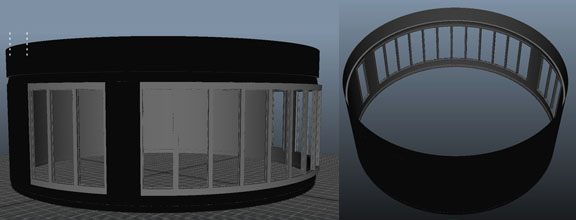
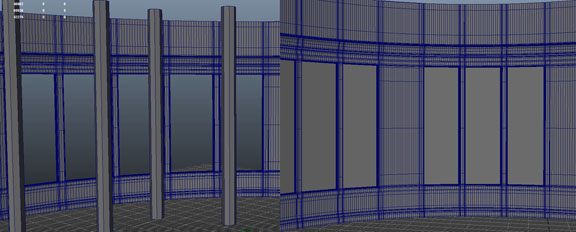
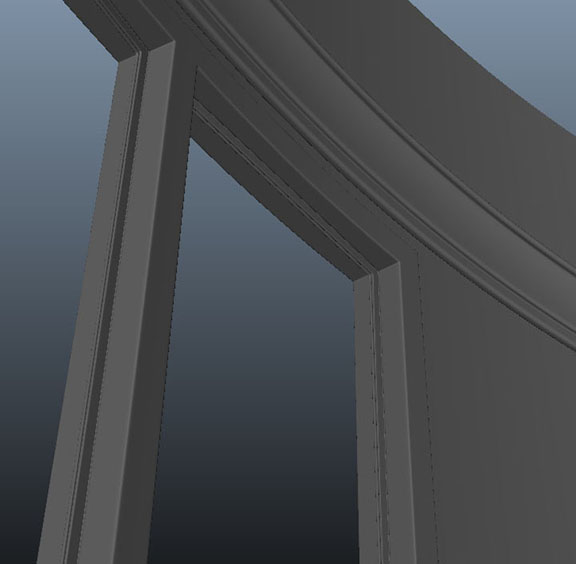
The last thing that I did in my gallery was block in the columns and major furnishings. This process actually caused me to resize and slightly reproportion my room when I discovered how little room I had left for the reading nook. The way I see it, your average couch is probably around five feet in length; when I made my couches that long they took up very nearly the entire floor space of the reading nook, leaving no space to actually access the bookshelves. So, I thought again. I moved the five-foot couch place-holders over to the reading nook area of the floor plan, then resized the floor plan image plane to fit them, leaving enough room to walk around and between the couches to navigate the nook area. Then I scaled the walls up evenly to fit the newly resized floor plan. I then scaled the height of the walls back down so that my ceilings weren't ridiculously high. In a room this grand, I do want high ceilings, but not completely, outrageously high. I've decided on an eight inch crown molding at nine feet with the actual ceiling topping out at twelve feet. I've been in houses with nine foot ceilings before and they're really nice, but I think that in a forty-five foot in diameter room (which is what the gallery turned out to be after resizing for the nook) they'd make the space feel just a little bit claustrophobic; so I settled on twelve foot ceilings. I then spaced out place holders for the columns and bookcases surrounding the reading nook, and that was the end of my work for the day.

For the next few days, I finished sculpting my Addict:
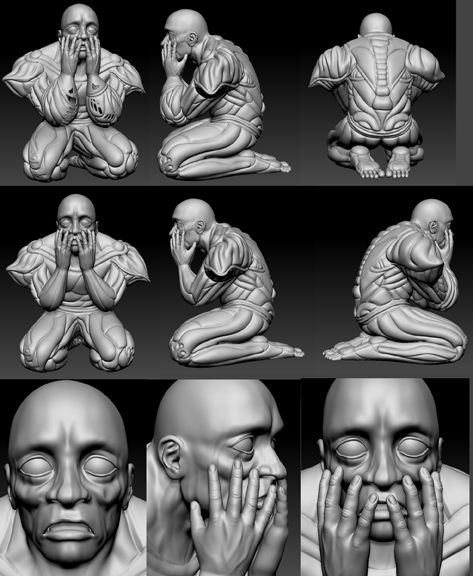
Tareq had mentioned when I turned in my last week's progress that the character's wrists looked broken: that the hands met the arms at the wrong angle. I worked to remedy that problem, then went on to finish sculpting the face, refining the hands, and sculpting the divisions into the forearm sleeves. Then I exported the 2nd subdivision level character mesh, unfolded the UVs a bit, and baked my normal maps:

I was concerned that I was going to get a lot of problem areas in the normal map where the geometry of one part of the body pressed against the geometry of another part in the pose that he's in (i.e.: the fingertips pressing against the face, the back of the thighs pressing against the calves, the inner elbows pressing against themselves), but, surprisingly, I had very few issues. I did end up separating out some pieces of the high- and low-res meshes and re-baking normal maps for certain areas (such as the face) and compositing the new maps into the the full body one, but I didn't have to do this for nearly as many pieces as I expected to: most of the anomalies in the map were able to be fixed with just a bit of healing brush application in Photoshop.
Then I started work on the color map.
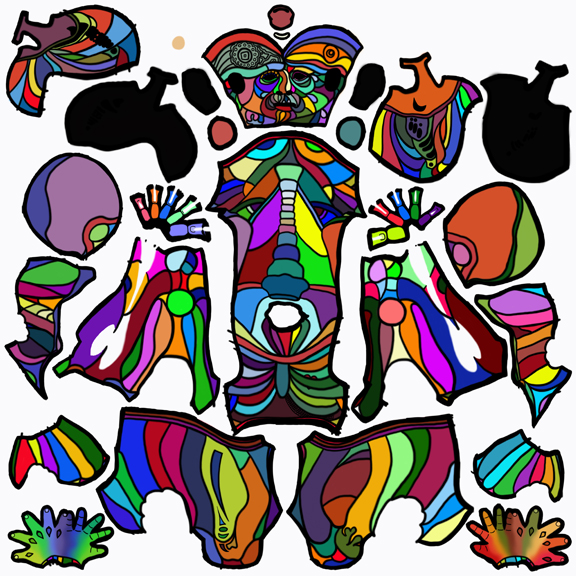
The image above took about a day's worth of work to complete - a very full day of work, but a day nonetheless. In this map, nearly all of the precise divisions are done. The shoulder pads and the ears still have to be subdivided according to the information in the normal map, but the rest of the precise linework is done. It looked great on the model:

I figured that it would take another day or so to complete the designs in the color section on his body. After all, the designs are just doodling - most of the precise work was done.
Oh, how wrong I was...
My sculpting on my Addict will be done by the end of the weekend. It's almost there. I just have a bit of tweaking to do on the fingers (the fingernail details and overall finger positions particularly), a bit more tweaking of the facial expression (particularly so that the flesh of the face interacts with the fingertips), and refinement of the two forearm sleeve pieces (I've only just blocked the divisions of those pieces in so far). Other than that, his sculpting is finished:
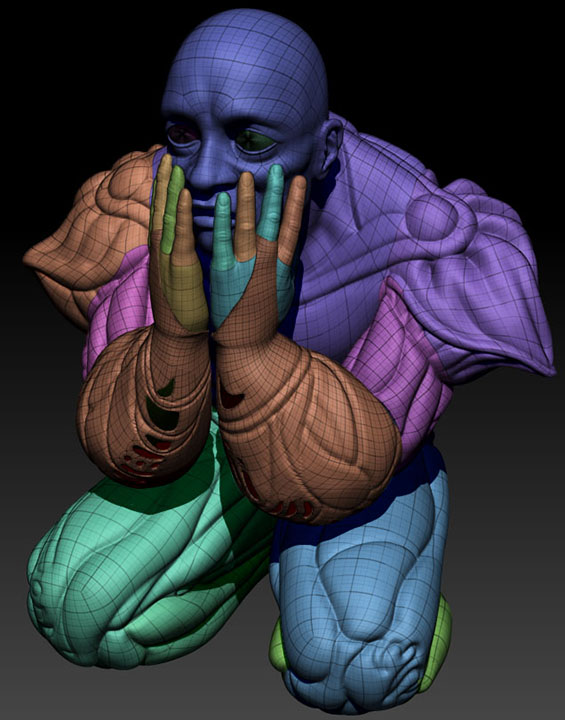



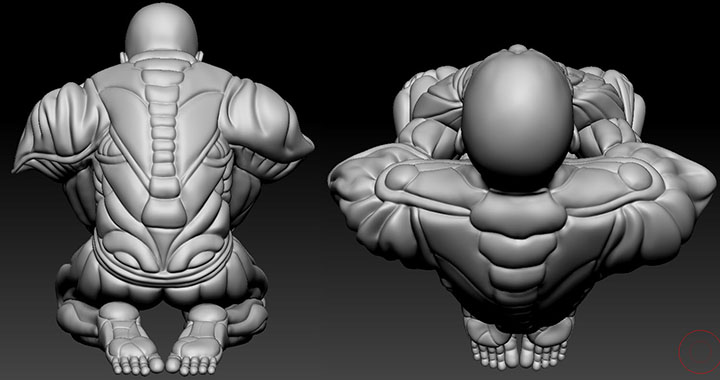

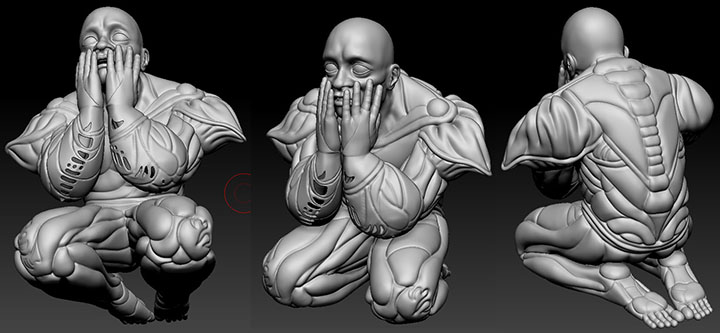
I thought that the sculpting of this model would be a "piece of cake" because nearly the entire thing was just refining the lines that I initially blocked in, but it was actually surprisingly difficult to get the defined areas to look right. I added volume to many sections that looked fantastic from the angle that I was primarily working from, then, when I turned the model, I'd notice that from another angle parts of the section would look flat or, worse, bumpy. When that happened I'd have to spend quite a bit of time inflating and smoothing, all the while going back and forth between subdivision levels to smooth and then check the progress. I don't think I've ever switched between subdivision levels as much as I had to while working on this model. I though that the smoothness of the shapes in this model would make it easier to sculpt, but it actually made it more difficult by leaving very little room for error. It almost had the feel of trying to organically sculpt a hard-surface piece, if that makes any sense.
I'm very excited to see it finished. I'm also a little nervous because I know that I'm going to have a hard time baking out the normal maps for the piece: there are a lot of areas where the geometry gets very close together and will likely cause errors during baking. I suspect that I'll have to break up some of the model by UV sections, bake the maps out piece by piece, then composite them together in Photoshop. I may give this model a short break after I finish the sculpting and wait for some feedback regarding my concerns from my instructors before I waste too much time in trial and error: perhaps there's an easier way that I'm just not familiar with. I can always spend a few days blocking out my environment model instead of moving on to texturing immediately. That way, I can still make progress on my thesis overall while waiting for advice on this particular model. I also wouldn't mind getting some opinions on the sculpting before I fully and finally commit to it by baking it into normal maps...
Well, I'm in the home stretch: the first week of my final semester has passed (and, boy, do I have a lot of work still to do...).
On a very positive note: I finished my Juggler! Finally! It only took about 8 times longer than I thought it would...
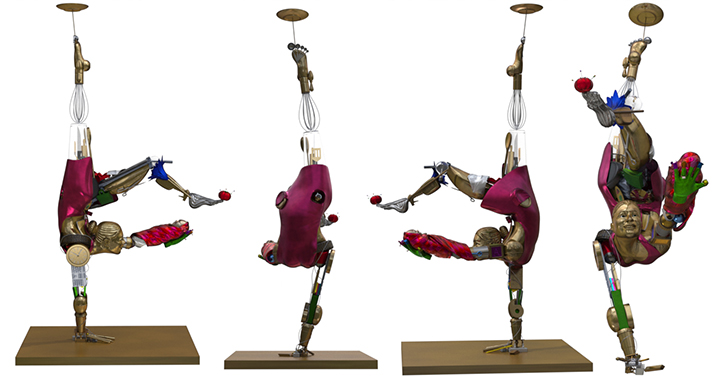
I learned a lot creating this model; it was much more complex than anything I've ever modeled before. When I planned my thesis schedule I'd only ever made character models that were one to ten pieces depending on whether they had mechanical parts or clothing or just one solid body. I'd never made anything composed of 60 different objects, many of which are made up of multiple pieces themselves. I had no idea of the scope of what I was taking on when I signed up for this, but I am thoroughly pleased with the results.

I actually had a lot of technical difficulties while on my vacation, so the vast majority of the final work on this model was done after I returned home. I had quite a bit of trouble baking out usable normal maps of all of my ZBrush sculpting on the more organic objects, but I eventually figured out how to remedy that by compositing multiple maps of the same object baked with different envelope sizes together and using healing brushes in Photoshop. I spent a lot of time baking those maps in Maya and more time compositing them, but eventually I was able to move on and bring everything into Modo, which was where my real trouble began.
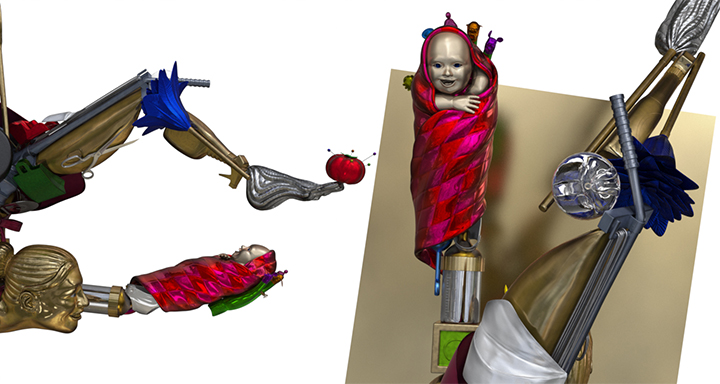
I had too many textures. Too many normal maps, too many color maps, too many reflections to be calculated on too many different pieces: Modo didn't want to handle my scene. The real-time render preview kept freezing and crashing the program. I eventually figured out a way to work in which I hid the textures on every object except the limb or even just the individual piece that I was working on; then I was able to make some progress.
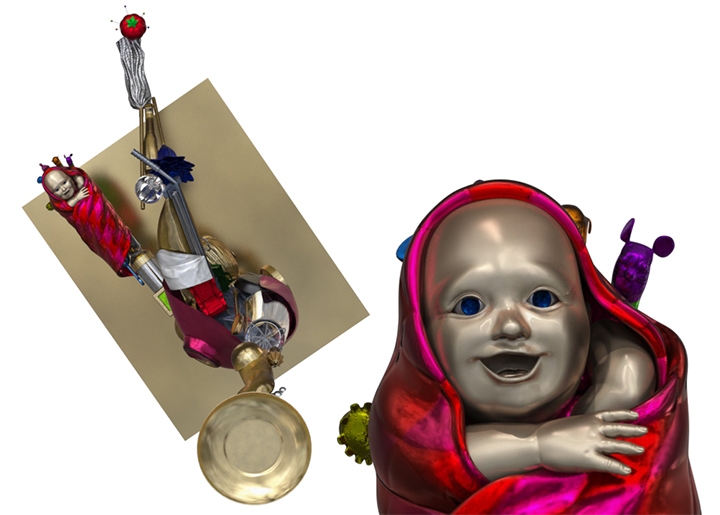
I gave all of my final objects the appropriate metal textures (many of which I had only to duplicate from other pieces which I had already designated to have the same material), then I began trying to tone down the uber-shiny metal look. It took a lot of trial and error, but eventually I came up with a combination of noise and gradient masks that made the metal look a little less perfect than it started out to be. I then applied variations of these masks to each and every one of the well over 100 different textures that I have applied to the model. It was a time-consuming process, but well worth it; everything still looks metallic to me, but like metal that's spent a little time out in the world, not like a shiny new penny hot off the press:

Some of the noise masks in the above images are still a bit extreme - you can tell that they're noise rather than grime - but I toned them down after seeing these renders. I haven't made new renders yet because it's a bit more of an ordeal to go through to set the renders up than I'd like to deal with right now. I have to open the file in the "modeling" tab which doesn't have the render preview screen built in, turn off all of the textures (which I've put into groups by body area to make the process easier), switch to the "render" tab and position my camera in the render preview window, switch back to the modeling tab, and then go straight to the final "render" from the drop-down menu without seeing the textured preview first. Then, if I need to change views I turn all the textures off and do it all again. It's the only way it works. My computer is good, but it doesn't contain enough ram to let Modo calculate this textured model moving in the preview render screen. I've just got too much going on in it. The final renders, however, calculate much faster than I expected them to given how much trouble I'm having with the preview renders.
Overall, I'm happy with my Juggler. There are still a few things about her that I would like to tweak: I'd like to add some bump maps of etched designs on quite a few of the objects that make her up. I might change a few colors around. I don't think her head is holding its normal map quite as well as I would like: she lost a little bit of volume from what's there in my actual ZBrush sculpt. The apron has a similar problem: I sculpted wrinkles in the fabric that just aren't showing up as much as I'd like with that pink metal texture. I think that my "grime" masks made her just the tiniest bit too dark for what I'd prefer... But these are little things. I think it's important for me to move on now and finish the rest of my thesis. If I can come back and fix them later after I finish the rest: fantastic, but I can't deal with it now. She's 95% to where I want her to be; it's time to call it "good enough" and bring the rest of my project to completion. I could have as long as a month left in the semester after I present my thesis project - I can tweak the little things then.
So, I've moved on to my Addict. This is the state that I left him in back in the spring:
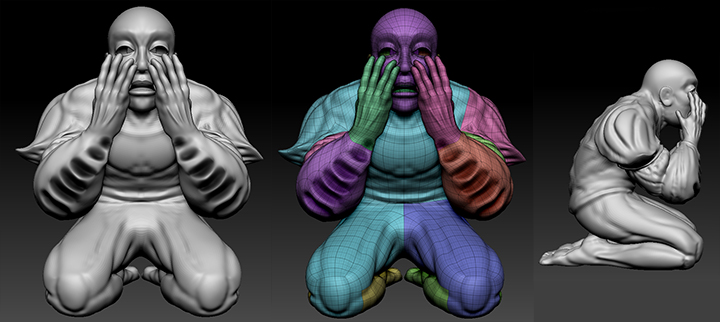
I kept having trouble with the holes in his sleeves. I thought that I could just hollow out the distance between his arm and his inner sleeve in ZBrush, but I hadn't really made the topology to support the right shapes for that. Looking back at it earlier this week I decided it was no good: I had to re-do it. With all of the experience that I gained from the Juggler I looked at this model and saw numerous areas where I was going to have major issues baking out normal maps, even if I managed to fight the topology and sculpt the right shapes in ZBrush. The thing is, I shouldn't have to be fighting the topology: it should be flowing with my sculpting, and the more that I studied this model the more that I knew that wouldn't be the case. So, I went back to my most recent version of him in Maya and re-made his arms. And his toes. And tweaked his hands and his shoulder pads. And fiddled with a few other issues that I found. Then I divided him into the appropriate groups once more and brought him back into ZBrush where I blocked in his sculpting again. This is his current state:
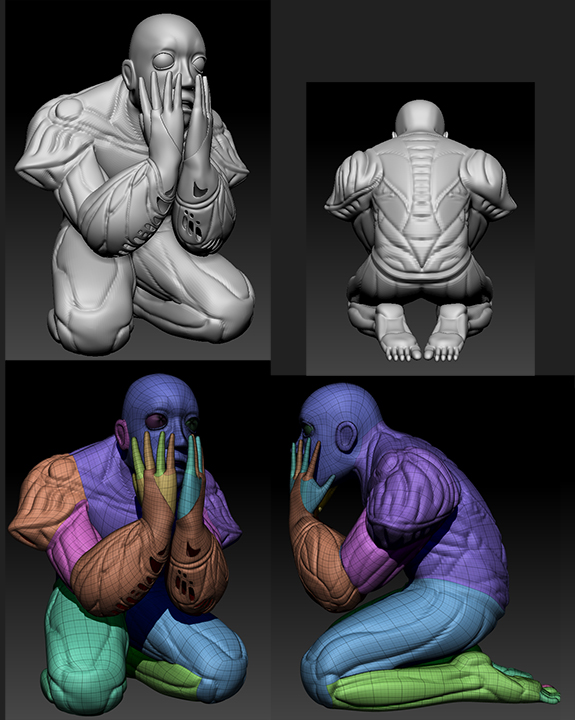
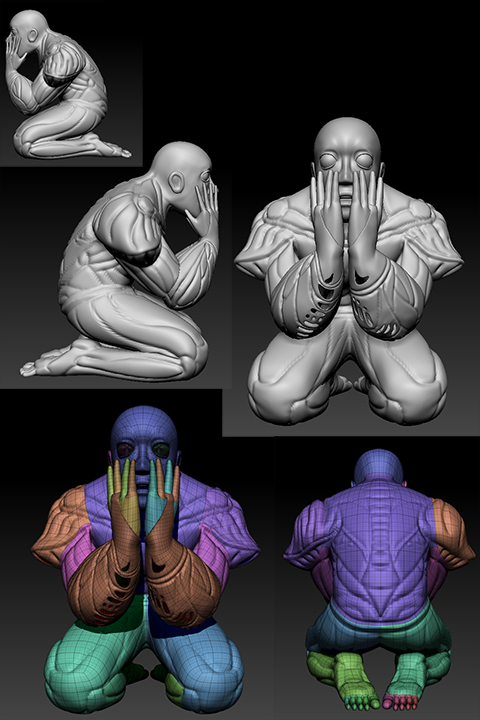
As you may be able to tell, I made each of his sleeves below the elbow into separate pieces from the rest of the body and built the holes into the mesh: it seemed the only way to get it to work properly. I also gave him real, individual toes rather than one solid block to be sculpted into toes. I'm a bit concerned that the model that I modified was not actually my most recent base mesh of the character, but it was the latest one that I found a file for. I'm concerned because the posture differs slightly from the version that I was sculpting before, and there was a row of unmerged vertices in an area that I hadn't modified that instantly separated when I brought the revised mesh back into ZBrush. I took it back into Maya and fixed it, obviously, but I keep wondering what else is different between the two meshes. Were there problems with the mesh that I made modifications to that had been fixed on the version that I'd previously been working on in ZBrush? I've already noticed quite a difference in the shape of the eyes between the two meshes, and am not sure if that's something that I'd fixed in the base mesh in Maya or simply by utilizing the move brush in ZBrush on the first model. I'm going to try refining the eye shape of the new model in ZBrush, but I'm concerned that I'll get into sculpting it and then notice something big enough to cause me to have to go back to revise the base mesh again...
I'm going to progress on the theory that that's not the case, however, and hope that I can just move on from here and get this character sculpted and begun texturing within the week. I don't see anything particularly wrong with the mesh, just things that are different from the previous version, and I know that I tweaked the previous version quite a bit to get the posture right, so it concerns me if that work failed to follow through to the revised character. I think it's ok though: from what I can see now he still looks right to me, so I'm going to continue sculpting him and just make sure that I keep a close eye on his overall shape. Hopefully, when I post in another week, he'll be nearly done.